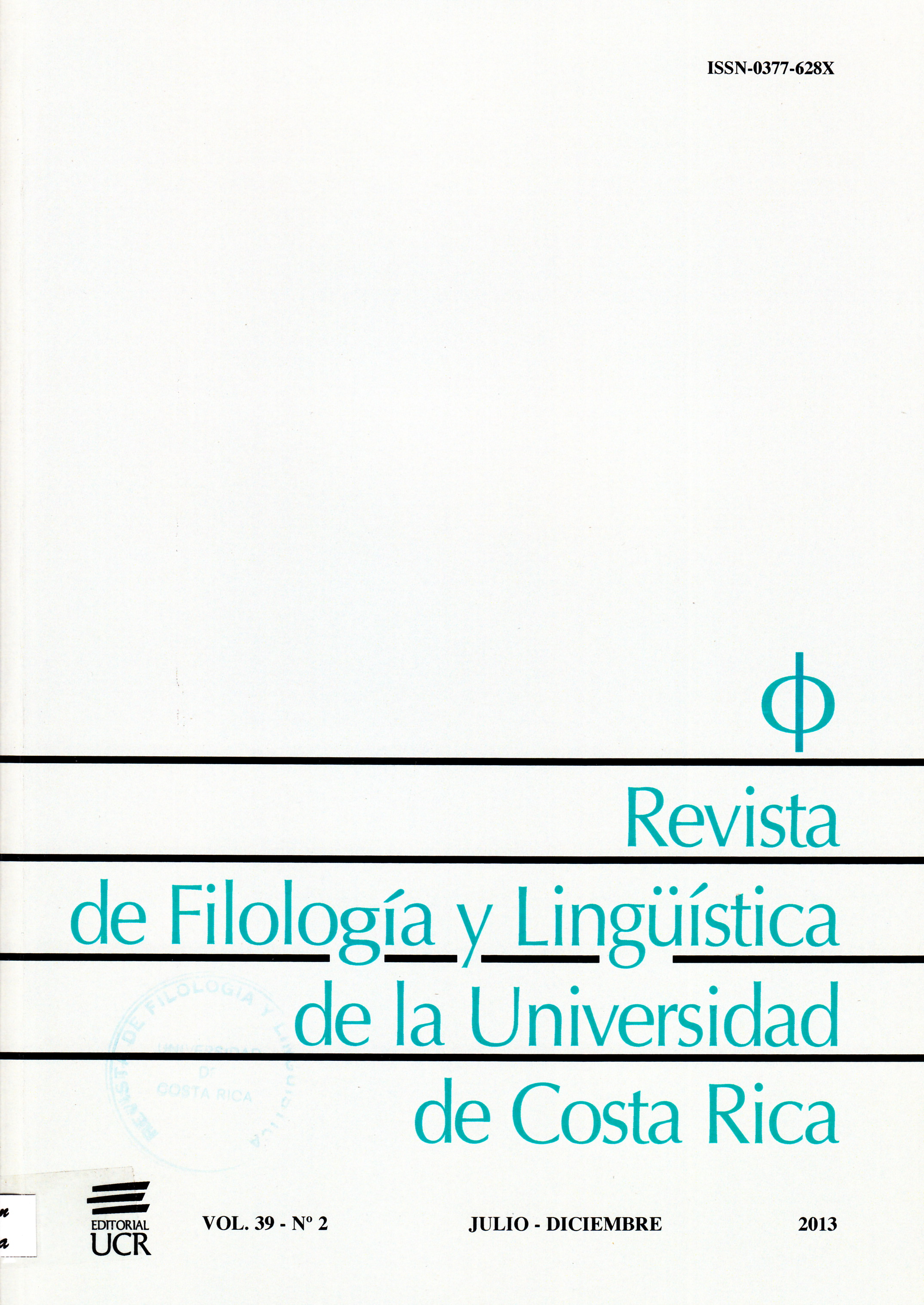Abstract
In this article, we make an exhaustive survey of the representation of the dead city in European and Spanish literature of the end of the century, with special interest in Rodenbach of Belgium and Azorin of Spain. First, we introduce by this literary convention, the current state of this critical issue and the reasons for its emergence in European literature at the end of the century. Second, we identify the most important manifestations of this motif in European literature, with special emphasis on The Dead City of Bruges (1892), by Georges Rodenbach, who initiated the rise of this motif in the symbolism of the turn of the century. Also, we identify the most important manifestations of the dead city in the literature of the Generation of 98, which is principally the case of Azorin (Toledo, Yecla, Lantigua, Villena), Baroja (Toledo, Alcolea del Campo) and Machado (Soria). Finally, we discuss the dead cities of other authors of Spanish and Latin American literature, beyond the 98 Generation: Vetusta, in The Regent's Wife, Leopoldo Alas y Ureña (also known as Clarín) or Ypres (in The Chronicles of Enrique Gómez Carrillo).
References
Bajtín, Mijaíl. 1986. Problemas literarios y estéticos. México: Alianza.
Baroja, Pío. 2002. El árbol de la ciencia. Madrid: Alianza.
Camino de perfección. Madrid: Alianza.
Berg, Christian; Durieux, Frank y Geert Lernout (Eds.). 1995. The turn of the Century. Le tournant du siècle. Modernism and Modernity in Literature and the Arts. Le
modernism et la modernité dans la literature et les arts. Berlin: Walter de Gruyter.
Castro, Rosalía de. 2003. Poesía. Madrid: Alianza.
Clarín, Leopoldo Alas. 2000. La regenta. Madrid: EDAF.
Cuvardic García, Dorde. 2009. “El debate Modernismo-Generación del 98”. Reflexiones. 88 (2): 101-112.
Friedman, Donald Flanell. 1990. The symbolist dead city. A Landscape of Poesis. New York: Garland.
García Pérez, Rafael. 2008. “Interpretaciones del tópico de la ciudad muerta en la poesía española y francesa”. Cédille. Revista de estudios franceses. 4: 119-130.
Gleber, Anke. 1995. “The Secret Cities of Modernity: Topographies of Perception in Georges Rodenbach, Robert Walser, and Franz Hessel”. En: Berg et al. (Eds.), 363-379.
Gómez Carrillo, Enrique. 1919. Obras completas. Tomo IV. Vistas de Europa. Madrid: Mundo Latino. 235-254.
El quinto libro de las crónicas. Madrid: Mundo Latino.
Gorceix, Paul. 1992. Reálités flamandes et simbolisme fantastique. Bruges-la-Morte et Le Carilloneur de Georges Rodenbach. Paris: Lettres Modernes.
Hinterhäuser, Hans. 1980. Fin de siglo: Figuras y mitos. (Trad. María Teresa Martínez). Madrid: Taurus.
Lamiquiz, Vidal. 1973. Ciudades en Azorín. De León por Córdoba a Sevilla. Interpretación semántico-estilística. Sevilla: Anales de la Universidad Hispalense. Publicaciones de la Universidad de Sevilla.
Langer, Peter. 1984. “Sociology-Four images of organized diversity: bazaar, jungle, organism, and machine”. En: Rodwin y Hollister (Eds.), 97-117.
Litvak, Lily. 1979. Erotismo fin de siglo. Barcelona: Bosch.
“Hacer visible lo invisible. El Simbolismo en la pintura española del paisaje, 1891-1930”. Magazine Modernista. Revista digital para los curiosos del modernismo.
López Martínez, María Isabel. 2007. El tópico literario: teoría y práctica. Madrid: Arco.
Lotman, Iuri. 1996. “El símbolo en el sistema de la cultura”. La semiosfera I. Madrid: Cátedra. 143-156.
Lozano Marco, Miguel Ángel. 2000. Imágenes del pesimismo. Literatura y arte en España. 1898-1930. Alicante: Universidad de Alicante.
Lugones, Leopoldo. 2010. “El solterón”. En: Serna y Castany (Eds.), 290-296.
Machado, Antonio. 1998. Campos de Castilla. Madrid: Biblioteca Nueva.
Mann, Thomas. 2005. Muerte en Venecia. Barcelona: Edhasa.
Martín, Francisco J. 2000. “Introducción”. En: José Martínez Ruiz (Azorín). Diario de un enfermo Diario de un enfermo. Madrid: Biblioteca Nueva.
Las novelas de 1902. Sonata de Otoño, Camino de Perfección, Amor y pedagogía, La voluntad. Madrid: Biblioteca Nueva.
Martínez Ruíz, José (Azorín). 1968. Las confesiones de un pequeño filósofo. Madrid: Espasa-Calpe.
a. Castilla. Madrid: EDAF.
b. La voluntad. Madrid: Biblioteca Nueva.
Doña Inés. Historia de amor. Madrid: Acento.
Antonio Azorín. Madrid: Biblioteca Nueva.
Lecturas españolas. Clásicos y modernos. Al margen de los clásicos. México: Porrúa.
Diario de un enfermo. Madrid: Biblioteca Nueva.
a. El alma castellana (1600-1800). Madrid: Biblioteca Nueva.
b. Don Juan. Madrid: Biblioteca Nueva.
Naupert, Cristina. 2001. La tematología comparatística. Entre teoría y práctica. Madrid: Arco.
Ortega y Gasset, José. 1957. “Azorín o primores de lo vulgar”. Obras completas. Tomo II. El espectador (1916-1934). Madrid: Revista de Occidente.
Pérez Galdós, Benito. 2000. Miau. Misericordia. Doña Perfecta. Madrid: Edimat.
Peyraga Pascale (Coord.). 2009. Los retratos de Azorín: en la encrucijada de unas subjetividades. Instituto de Cultura Juan Gil Albert.
Pike, Burton. 1981. The Image of the City in Modern Literature. Princeton: Princeton University Press.
Prieto de Paula, Ángel. 2006. Azorín frente a Nietzsche y otros ensayos noventayochistas. Alicante: Aguaclara.
Regoyos, Darío y Émile Verhaeren. 1963. España negra. Madrid: Taurus.
Rodenbach, Georges. 1930. Poesías. Barcelona: Cervantes.
Brujas la muerta. Madrid: Vaso Roto.
Rodwin, Lloyd y Robert M. Hollister (Eds.). 1984. Cities of the mind. Images and themes of the city in the social sciences. New York: Plenum.
Sanz Pastor, Marta. 2007. Metalingüísticos y sentimentales. Antología de la poesía española (1966-2000). 50 poetas hacia el nuevo siglo. Madrid: Biblioteca Nueva.
Serna Arnaiz, Mercedes y Bernat Castany Prado (Eds.). 2010. Antología crítica de poesíamodernista hispanoamericana. Madrid: Alianza.
Shaw, Donald L. 1997. La generación del 98. Madrid: Cátedra.
“More about Abulia”. ALEC. 23: 451-464.
Valle-Inclán. 1990. Sonata de primavera. Sonata de estío. Sonata de otoño. Sonata de invierno. México: Porrúa.
Verhaeren, Emile y Darío de Regoyos. 1963. España negra. Madrid: Taurus.
Vigneron, Denis. 2009a. “Azorín et Darío de Regoyos; une sensibilité de l’Espagne à l’unisson”. En: Peyraga (Coord.), 121-138.
b. La création artistique espagnole à l’épreuve de la medernité esthétique européenne (1898-1931). Paris: Publibook.

